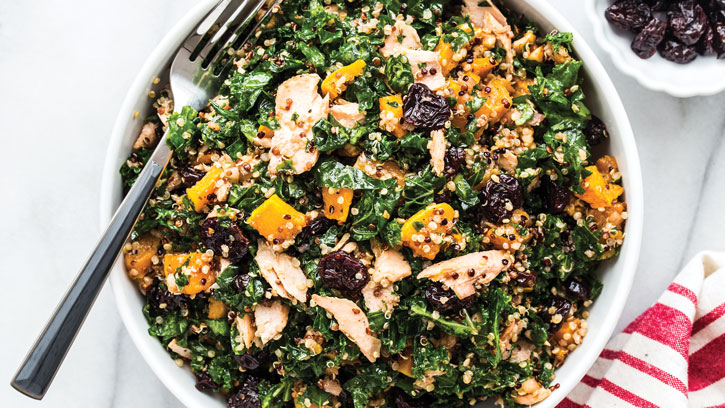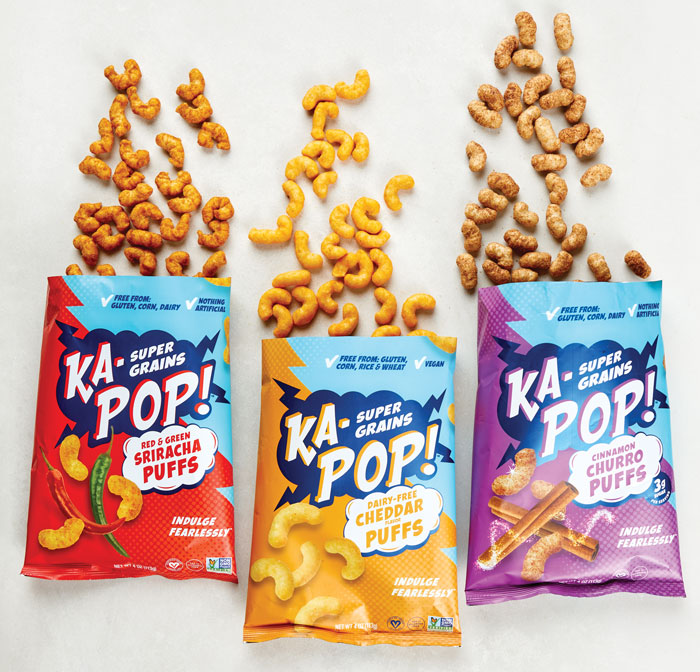Tapping Fruits, Grains to Achieve Dietary Guidelines Goals
NUTRACEUTICALS
Meeting food group needs with nutrient-dense foods and beverages while staying within calorie limits is one of the four core components of the 2020–2025 Dietary Guidelines for Americans. According to the Guidelines, “Nutrient-dense foods and beverages provide vitamins, minerals, and other health-promoting components and have little added sugars, saturated fat, and sodium.”
Fruits and whole grains are nutrient-dense, but people often don’t consume enough of them, resulting in inadequate intakes of nutrients they provide, including calcium, dietary fiber, and vitamin D. In addition to being nutrient-dense, fruits and whole grains address several of today’s consumer priorities: They are familiar, natural, wholesome, plant-based, and clean label. And research continues to demonstrate that fruits and whole grains deliver a wide array of health benefits. Here is a quick look at some of these nutrient-dense foods and their health-boosting properties.
Functional Fruits
“As a result of the pandemic, consumers are looking for ingredients that help strengthen their immune system. This focus on immunity has led to a rise in fruit ingredients that feature immunity-boosting vitamins, minerals, and antioxidants, such as raspberries, black currant, and kiwi,” observes Angela Lofthouse, global sales and R&D director, Chaucer Foods.
Fruits such as elderberry, aronia, and black currant will become more mainstream because of their contribution to immune health, predicts Heidi Farkas, national sales and marketing manager, Milne. “Aronia has the highest recorded antioxidants of any North American fruit, but it is not yet widely known,” she says. Berries are currently attracting consumer interest. “All berries—blueberries, raspberries, and strawberries—are popular in healthy food and beverage products,” Farkas continues. “They are low in calories, high in fiber, and loaded with antioxidants, which protect your body from free radicals.”
The phytochemicals and antioxidant and anti-inflammatory properties of fruits contribute to their benefits in areas like immunity, cardiovascular health, and even exercise recovery.
• Apples. “An apple a day keeps the doctor away” is the old adage, but recent research documents the benefits of consuming two apples each day. Koutsos et al. (2020) showed that mildly hypercholesterolemic individuals experienced beneficial hypocholesterolemic and vascular effects after daily consumption of proanthocyanidin-rich apples. Volunteers consumed 2 apples/day (Renetta Canada, rich in proanthocyanidins) or a sugar- and energy-matched apple control beverage for 8 wk. Whole apple consumption was associated with decreased serum total and LDL cholesterol and triacylglycerol.
• Aronia. Aronia, also known as chokeberry, has exhibited antioxidant and anti-inflammatory properties, and has been shown to benefit cardiovascular health. In a meta-analysis, Hawkins et al. (2020) demonstrated that daily supplementation with aronia berry extracts for 6–8 weeks reduced systolic blood pressure and cholesterol. The effects were most significant in adults over 50 years old.
• Blueberries. According to the U.S. Highbush Blueberry Council, investigators are currently pursuing five tracks to better understand the role that blueberries may play in promoting good health: cardiovascular health, insulin response, brain health, cancer research, and the gut microbiome. Research into the gut microbiome is still in the early stages; investigations in the other areas continue to advance, however.
Krikorian et al. (2020) showed that blueberry supplementation improved cognitive performance in older adults with mild cognitive impairment. The blueberry-treated group exhibited improved semantic access and visual-spatial memory, and there was a trend for enhanced speed of processing. Curtis et al. (2019) looked at long-term (6 mo) blueberry consumption and insulin resistance and cardiometabolic function in metabolic syndrome. They found that daily intake of 1 cup of blueberries improved endothelial function, flow-mediated dilatation, and systemic arterial stiffness and attenuated cyclic guanosine monophosphate concentrations. Du et al. (2019) studied the effect of freeze-dried whole blueberries in people with symptomatic knee osteoarthritis. The study subjects consumed 40 g freeze-dried blueberry powder daily for four months. Pain, stiffness, and difficulty performing daily activities decreased significantly in the blueberry treatment group.
• Elderberries. During the pandemic, consumers have become more aware of the immune health benefits that elderberries provide. Elderberries’ anthocyanin and flavonoid content contribute to their antioxidant and anti-inflammatory properties. Hawkins et al. (2019) conducted a meta-analysis, which included a total of 180 participants. Supplementation with elderberry was found to reduce upper respiratory symptoms.
Last year, Artemis International introduced BerryDefense Immune Blend, which contains standardized extracts of European black elderberry, aronia, and black currant. The high anthocyanin blend has a minimum 10% anthocyanin and 20% polyphenol content.
• Pomegranates. A meta-analysis conducted by Sahebkar et al. (2017) demonstrated benefits of pomegranate juice consumption on blood pressure and suggested that “it may be prudent to include this fruit juice in a heart-healthy diet.” Pomegranate juice is rich in polyphenols and exhibits antioxidant capacity. Quantitative data synthesis from 8 randomized placebo-controlled trials showed significant reductions in both systolic and diastolic blood pressure after pomegranate juice consumption.
• Tart Cherries. Montmorency cherries have been studied because of their high antioxidant and anti-inflammatory properties as well as melatonin content. Studied for sleep, arthritis, and gout relief, tart cherries are also thought to help in exercise recovery thanks to their anti-inflammatory properties. In a recent meta-analysis, Hill et al. (2021) concluded that consumption of a tart cherry supplement can aid aspects of recovery from strenuous exercise. Data from 14 studies showed that tart cherry supplementation had a small beneficial effect in reducing muscle soreness. A moderate beneficial effect was observed for recovery of muscular strength. A moderate effect was observed for muscular power; a further subgroup analysis on this variable indicated a large effect of tart cherry supplementation on recovery of jump height and a small significant effect of supplementation on sprint time. A small effect was observed for both C-reactive protein and Interleukin-6.
Because they are available in a variety of forms, including powders and freeze-dried, nutrient-dense fruits are being added to a growing list of food and beverage products. “Consumers have become more attentive to what’s in their food and beverage products and are avoiding items that include preservatives and artificial additives, which are prevalent in some fruit inclusions and ingredients to enhance flavor, appearance, or shelf life,” says Lofthouse. “Chaucer’s freeze-dried fruit ingredients are all-natural and have full field-to-fork traceability, so they are aligned with the trend toward healthier, more sustainable, and clean label foods. They contain no added sugars, artificial preservatives, or carriers.”
Freeze-dried fruits can add vibrant flavors and crisp textures to snacks and enhance the nutritional appeal of fruit smoothies. “Another up-and-coming category is freeze-dried fruit powders, which are increasingly being used to add natural flavor and color to beverages. They can be used as an instant mix for functional waters, tea, cocktails, and mocktails, or as a functional base blend for protein smoothies and shakes,” says Lofthouse. “The freeze-drying process also retains key nutrients, making freeze-dried fruit powders a valuable addition to immunity-focused or nutritionally focused beverage products.”
Farkas says that Milne team members are seeing real fruits used in distilled beverages, seltzers, and flavored waters. “They are also used in confectionery items, where traditionally a flavor would be used,” she notes. There’s even a trend toward using more premium fruits with a functional impact in pet foods, Farkas adds.
Milne MicroDried ingredients are 100% all-natural dried fruits that retain high levels of polyphenols. “We are seeing whole powders being added to cold juice/beverage applications versus in tea/steeped applications so that more nutritional benefits are achieved,” says Greg Anchondo, Milne regional sales manager. “On a side note, we are seeing vegetables added to beer and spirits. Unique flavor combinations are encouraged in today’s market, so we are seeing requests for several of our fruit and vegetable ingredients in the same project.”
Wholesome Ancient Grains
Whole grains offer health benefits in areas like weight management, reduced risk of type 2 diabetes, and heart health. Marshall et al. (2020), for example, conducted a meta-analysis that concluded that for adults with or without cardiovascular disease risk factors, consuming whole grains as opposed to refined grains can improve total cholesterol, low-density lipoprotein cholesterol, hemoglobin A1c, and C-reactive protein.
While mainstream whole grains like oats, barley, rye, and whole wheat are more familiar to consumers, ancient grains, in particular, are drawing interest as they, too, offer wholesome, nutritional, and clean label appeal. The Whole Grains Council generally defines ancient grains as grains that are largely unchanged over the last several hundred years. Examples of ancient grains include buckwheat, amaranth, teff, and ancient wheats, including spelt, emmer, and farro.
• Amaranth. Rich in protein compared with most other grains, amaranth is gluten-free. Amaranth is a complete protein, containing all nine essential amino acids. Reported health benefits of amaranth include antioxidant activity and cholesterol level reduction.
• Buckwheat. Buckwheat consumption has been linked to digestive health as well as heart health. Like amaranth, buckwheat is a complete protein and is gluten-free. Buckwheat is high in dietary fiber, adding to its potential role in regulating weight as well as blood sugar.
• Millet. Millet is gluten-free and exhibits high antioxidant activity. It is also a source of phosphorous, magnesium, and calcium. Millet consumption has been shown to potentially help with blood sugar and cholesterol control. Narayanan et al. (2016), for example, demonstrated that in people with type 2 diabetes, replacing a rice-based breakfast with a millet-based one lowered blood sugar levels after the meal.
• Quinoa. Quinoa is a great example of an ancient grain that has become mainstream. Quinoa contains all nine essential amino acids the body requires. In addition, it is high in fiber and gluten-free. Last year, Ingredion introduced a quinoa flour, HOMECRAFT Quinoa, offering the advantages of the whole grain. It is milled from a proprietary waxy variety of the golden quinoa seed and is sustainably and reliably sourced from Canada.
• Sorghum. Sorghum is a good to excellent source of iron and zinc and is rich in B complex vitamins. Xiong et al. (2019) discussed the nutritional composition of sorghum. Sorghum grain is a rich source of nutrients and beneficial phenolic compounds. The phenolic profile of sorghum is unique and more abundant and diverse than other common cereal grains. Studies have shown that sorghum phenolic compounds have potent antioxidant activity in vitro, and consumption of sorghum whole grain may improve gut health and reduce the risks of chronic diseases.
REFERENCES
Curtis, P. J., V. van der Velpen, L. Berends, et al. 2019. “Blueberries Improve Biomarkers of Cardiometabolic Function in Participants with Metabolic Syndrome-results from a 6-month, Double-blind, Randomized Controlled Trial.” Am. J. Clin. Nutr. 109(6): 1535–1545.
Du, C., A. Smith, M. Avalos, et al. 2019. “Blueberries Improve Pain, Gait Performance, and Inflammation in Individuals with Symptomatic Knee Osteoarthritis.” Nutrients 11(2): 290.
Hawkins, J., C. Baker, L. Cherry, et al. 2019. “Black Elderberry (Sambucus nigra) Supplementation Effectively Treats Upper Respiratory Symptoms: A Meta-Analysis of Randomized, Controlled Clinical Trials.” Complement. Ther. Med. 42: 361–365.
Hawkins, J., C. Hires, C. Baker, et al. 2020. “Daily Supplementation with Aronia melanocarpa (chokeberry) Reduces Blood Pressure and Cholesterol: A Meta-Analysis of Controlled Clinical Trials.” J. Diet. Suppl. Aug. 14: 1–14. Online ahead of print. doi: 10.1080/19390211.2020.1800887.
Hill, J. A., K. M. Keane, R. Quinlan, and G. Howatson. 2021. “Tart Cherry Supplementation and Recovery from Strenuous Exercise: A Systematic Review and Meta-Analysis.” Int. J. Sport Nutr. Exerc. Metab. Jan. 13: 1–14. Online ahead of print.
Koutsos, A., S. Riccadonna, M. M. Ulaszewska, et al. 2020. “Two Apples a Day Lower Serum Cholesterol and Improve Cardiometabolic Biomarkers in Mildly Hypercholesterolemic Adults: A Randomized, Controlled, Crossover Trial.” Am. J. Clin. Nutr. 111(2): 307–318.
Krikorian, R., W. Kalt, J. E. McDonald, et al. 2020. “Cognitive Performance in Relation to Urinary Anthocyanins and Their Flavonoid-based Products Following Blueberry Supplementation in Older Adults at Risk for Dementia.” J. Funct. Foods 64: 103667.
Marshall, S., P. Petocz, E. Duve, et al. 2020. “The Effect of Replacing Refined Grains with Whole Grains on Cardiovascular Risk Factors: A Systematic Review and Meta-analysis of Randomized Controlled Trials with GRADE Clinical Recommendation.” J. Acad. Nutr. Diet. 120(11): 1859–1883.
Narayanan, J., V. Sanjeevi, U. Rohini, et al. 2016. “Postprandial Glycaemic Response of Foxtail Millet Dosa in Comparison to a Rice Dosa in Patients with Type 2 Diabetes.” Indian J. Med. Res. 144(5): 712–717.
Sahebkar, A., C. Ferri, P. Giorgini, et al. 2017. “Effects of Pomegranate Juice on Blood Pressure: A Systematic Review and Meta-Analysis of Randomized Controlled Trials.” Pharmacol. Res. 115: 149–161.
Xiong, Y., P. Zhang, R. D. Warner, and Z. Fang. 2019. “Sorghum Grain: From Genotype, Nutrition, and Phenolic Profile to its Health Benefits and Food Applications.” Compr. Rev. Food Sci. Food Saf. 18(6): 2025–2046.








